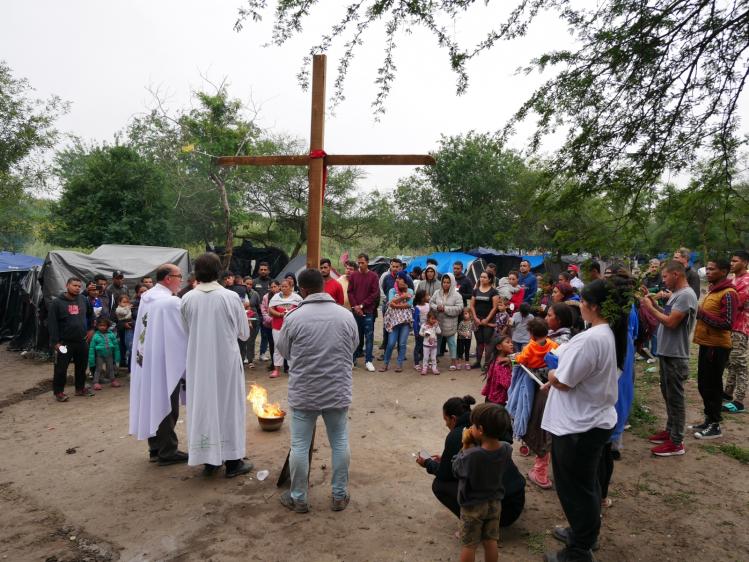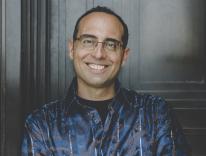
In a migrant camp, liturgy is an act of bricolage.
It’s Holy Thursday. I am in Brownsville, Texas, spending Holy Week with a community of Jesuits who minister to migrants throughout the Rio Grande Valley. The three of them—Brian Strassburger, Louie Hotop, and Flavio Bravo—live in a small, tidy house in the colonia of Cameron Park that they’ve named for Miguel Pro, the joyful Jesuit martyr executed during Mexico’s Cristero War.
Our car inches across Gateway International Bridge toward Matamoros, Brownsville’s Mexican sister city. Hemispheric political crises, coupled with restrictive, constantly changing U.S. immigration policies, have transformed border cities like Matamoros into sites of desperation for migrants driven from home by gang violence and economic collapse. The migrant camp first appeared there in 2018 and disbanded in 2021, after the termination of the Trump-era Remain in Mexico program. But near the end of 2022, the priests began to hear rumors that the Matamoros camp had reappeared. They drove across the border to find out. The rumors were true: the camp was back. But conditions had shifted. Though far from comfortable, the first camp had basic infrastructure. A trans-border network of NGOs and faith-based organizations, including Catholic Charities Rio Grande Valley, collaborated with Mexican authorities to provide access to showers, toilets, medical services, clothes-washing stations, food, and water. But government officials had lost patience with the camp. Prohibited from pitching tents in the plaza, migrants slept on sidewalks. Four months later, thousands are surviving in makeshift shelters down a steep embankment covered with mesquite trees and trash along the muddy bank of the Rio Grande.
The car is packed full of liturgical things and things made liturgical. A monstrance on loan from another church is zipped into the laptop pocket of a backpack. A brass thurible, borrowed and patinated with age, is nestled into a bright red HEB bag, and the bells adorning its chains jingle every time we hit a bump. The trunk holds other treasures: a stack of bilingual hymnals; metal folding chairs; a suitcase filled with vestments, an altar cloth, and tiny vials of water and wine; a giant speaker; sliced bread and bags full of grapes; a basket of white pipe-cleaner bracelets that Brian and Louie have strung with craft-store jingle bells for people to ring during the Gloria.
In the camp, wooden pallets stacked beneath a twisted mesquite tree become an altar. Extension cords run like rivers down from the base of each streetlight and fan out into deltas of cords on cords, and Flavio hooks up the speaker to the web of pirated electricity. We arrange the folding chairs next to the altar for the washing of the feet.
At this point we realize we’ve forgotten a critical element: water. Under normal circumstances, we’d just turn on the tap. But in a migrant camp, water is a fiercely guarded commodity. We hear about a fight that broke out over water the night before. Someone was stabbed. There are tanks throughout the camp, but some people say that the water makes them sick. Others try to drink from the river, but that makes them even sicker. “¿Quién tiene agua?” Flavio calls out in a voice that sounds more like an invitation than a request. Who has water? Someone comes forward with their jug and a plastic ladle. It’s the ultimate act of generosity—an act of holy waste. Water is precious because it is scarce, and here we are, Mary of Bethany, anointing people’s feet with it one ladle at a time. A grinning seven-year-old girl hops into the chair first, wiggling off her shoes and swinging her legs. A young woman with a toddler takes the seat beside her and the people around her help remove the little boy’s shoes as she removes her own. The priests bend low to wash, dry, and kiss each pair of feet.
That night it rains ferociously. The littered earth becomes mud, and no one sleeps. People dig trenches around their tents to try to divert the water, but nothing can stop the rain from lashing apart shelters. The next morning, the road into Matamoros is flooded and chaotic. In the camp, people stand huddled with their arms pulled into their shirts. A mother named Yanetzy sits on an overturned bucket, her three-year-old daughter curled in a damp blanket on her lap. Yanetzy’s cherry-red hair is streaked with brown, and I can tell how long ago she left home in Venezuela by how far her roots have grown out. All I can think is that she is the most tired person I have ever seen.
But there are small wonders, too. This morning a woman finally received her cita—her appointment for asylum processing by border patrol. Asylum-seekers are required to use a smartphone app called CBP One to request entry into the United States. The system is effectively a lottery: every day at 10 a.m., migrants enter their information into the glitchy app in the hopes of securing a coveted appointment at a port of entry. Nearly everyone is denied, with no other choice but to try again the next day, and the next. But once in a while, the stars align. A Good Friday miracle.
Before we left Casa Miguel Pro, Louie and Flavio had packed the car with a stack of flattened cardboard boxes that had been accumulating against their kitchen wall. Now, they spread the boxes on the ground and lean a crucifix retrieved from the trunk against the makeshift altar. When the service begins, the priests step forward in silence and flatten their bodies onto the cardboard on top of the mud. Prostrate before the foot of the cross, they press their faces into the same unforgiving ground on which everyone else has spent a sleepless night, and the soles of their shoes, which face the sky, are, like everyone else’s, caked in mud.
The liturgy ends with a via crucis through the middle of the camp. The procession winds up the mud-slicked hill and into the flooded street, through a metal turnstile, and into the plaza at the foot of the international bridge. We carry a ten-foot cross that a man in the camp has built from two giant pieces of scrap wood. When we return to the site of the altar, someone is waiting. He wants to know if he can keep the cardboard for the floor of his tent.
The bishop has given the Jesuits permission to celebrate the Easter Vigil early, so on Saturday we leave for Matamoros after lunch. There is a stainless-steel mixing bowl covered with a baking sheet on the floor of the passenger seat, and I’m instructed to make sure it doesn’t tip over. I glance inside the bowl. “Epsom salt and rubbing alcohol,” Louie explains before I have a chance to inquire about the science experiment at my feet. “For the fire.”
Today, CPB One is giving everyone the same error message: “You must be near the southwest border of the United States to make an appointment at a port of entry.” The app uses geolocation to require that users be north of Mexico City to apply. The error is ridiculous, of course. Any closer to the border and we would all be in the water. The app isn’t the only thing malfunctioning. The electricity isn’t working in the usual spot, either. “¿Quién tiene luz?” Flavio calls out. Who has power? A group of men across the way summon us over to their electrical strip.
A man offers to hold the towering scrap-wood cross, and we stand in a circle in the middle of the camp. Louie lights the bowl, and silky red flames erupt from the ground between us. He lowers a candle into the paschal fire and raises it to the sky. “¡Luz de Cristo!” he sings. “¡Gracias a Dios!” we respond. Three times we repeat the refrain, falling into a procession behind the Easter candle. We light our candles from the flame and splotches of wax fall like raindrops onto the gray-brown earth.
At some point, children playing on the hillside decide to become a band of altar servers, and they are visibly enthralled to discover that their newly assumed responsibilities include retrieving the smoldering thurible from the tree branch where it hangs. Louie blesses the altar and the gifts. Then he walks to the front of the altar to bless the people. Slowly and with great care, he moves around the circle, gently swinging the thurible before each person. When he reaches the edge of the crowd, he returns to the center, closes his eyes, and bows to them.
On the ride home, my mind turns to my students, who sometimes ask the question that any rational person faced with reality asks: What good are candles and incense and bells when people are starving? I usually reply that we would do well to be suspicious of the capitalist assumption that prayer is only for people who can afford things. I see now that the real answer is whatever I just witnessed.
In the end, when the last fire burns itself out and the last mesquite tree falls and the final light goes out, when the rain washes away the trash and the mud and the shit and the last bridge is crossed and the last detention center closed and Christ who died and rose comes again, reconciling everything to himself, and sin is no more, and death is no more, and nothing is wasted, we’ll meet and bow to one another, and there we’ll stand, Christ and all of us, our feet washed, our wounds kissed, our heads perfumed.
Please email comments to [email protected] and join the conversation on our Facebook page.
Previous Story
A Patriarch Flees Baghdad
Next Story
Nolan Goes History Channel Mode
